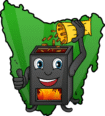Pellet heaters are an innovative and efficient home heating solution that are popular in Tasmania and gaining popularity in the rest of Australia. Pellet heaters burn compressed wood pellets to heat and are extremely efficient, easy to use and environmentally friendly. However, the story of pellet heaters spans several decades, and their journey from sawdust to sustainability is interesting to say the least.
Here’s a quick breakdown of the history of pellet heaters:
- The technology to create pellets was invented in the 1930s
- Bark was turned into pellets in the 1950s and 1960s to reduce waste
- The oil crisis of the 1970s kicked started pellet heaters for home heating
- Modern pellet heaters today continue to innovate and improve
The Great Depression Era (1930s)
During the 1930s, the technology used to create wood pellets was invented. Back then it was used to create feed pellets and while they didn’t exist yet and you couldn’t buy wood pellets for heating, this technology played a crucial role in the later years and laid the foundation for wood pellets and pellet heaters for home heating.
Post-War Period (1950s-60s)
In the post-war period of the 1950s and 60s, environmental concerns began to take centre stage. Researchers started exploring renewable energy sources as alternatives to fossil fuels. During this time bark was pelletised in the USA to reduce waste from sawmills. Wood pellets emerged as a promising option due to their potential to reduce carbon emissions and provide a sustainable heating solution. But it wasn’t until later before pellet heaters started to go mainstream.
Oil Crisis and Energy Shortages
The 1970s oil crisis had a significant impact on the heating industry, and this is when wood pellets and pellet heaters for home heating all began. With the rising costs of fossil fuels and the need for affordable and reliable heating options, pellet heaters and wood pellets for started to grow in popularity. Their efficiency and lower operating costs made them an attractive choice for homeowners looking to reduce their energy bills and for anyone that didn’t have access to or didn’t want to mess with firewood.
Technological Advancements
Early pellet stoves were often bulky and inefficient, but technological advancements brought about significant improvements. Innovations in auger feeding systems and combustion technology enhanced the efficiency and convenience of pellet stoves, making them more user-friendly and effective. Many early pellet heaters had to be manually lit, whereas today pellet heaters all start automatically.
Refinement and Diversification
As pellet heaters entered the modern era, they underwent further refinements to improve their performance and aesthetics. Manufacturers introduced more compact and stylish designs, catering to the diverse preferences of homeowners. The market expanded with a wider variety of models and brands, each offering unique features and benefits. Today if you want to buy a pellet heater your choice ranges from pellet heaters for budget minded people or high-end luxury European heaters, like a Piazzetta pellet heater.
Environmental Awareness
The growing awareness of climate change and the need for sustainable energy solutions has further boosted the adoption of pellet heaters in recent years. Homeowners are increasingly seeking eco-friendly heating options that reduce their carbon footprint while providing reliable warmth and comfort.
Technological Integration
In the modern era, pellet heaters have also embraced technological advancements. The integration of smart thermostats, Wi-Fi connectivity, and automated features has enhanced the convenience and control of pellet heaters. Users can now monitor and adjust their heating settings remotely, making pellet heaters more user-friendly than ever before.
Challenges and Opportunities in Australia
Australia presents its own set of challenges and opportunities for the adoption of pellet heaters. Wood heaters here are still a popular heating option, along with gas. There’s also a big lack of information and knowledge out there about pellet heaters, which doesn’t help. Despite these challenges, pellet heaters are slowly gaining popularity with Tasmania being the most predominant market in Australia.
Summary of the History of Pellet Heaters
I personally find the history of pellet heaters interesting and I hope you did too. While pellet heaters are much more popular in the USA and Europe, they are slowly growing in popularity in Australia. Tasmania is where you’ll find the most number of houses with pellet heaters, with Victoria and New South Wales growing markets on the mainland. I know they’ll continue to grow in popularity because they are efficient, cost-effective, and environmentally friendly alternative to traditional heating methods like wood heaters and gas heaters.
Resources
Pellets – A fast growing energy carrier
